We’re drowning in imagery these days: photos on the pages of newspapers and magazines, on televisions, smart phones, iPads and laptops; full-wrap ads on buses, trains and towering buildings; even a Lilliputian universe on our wristwatches.
Research shows that readers give most newspaper photographs about a second or less of their attention. And how often do you scroll through Facebook or Instagram -- and not even stop?
I admit I’m the same way -- until I get to Stuart Palley’s photographs.
I always thought that if I could photograph a wildfire amongst a national treasure or feature like the places in Yosemite National Park, it would put front and center wildfires and the related drought and climate issues in a context that people and lovers of the outdoors could relate to.
Palley is a Southern California-based freelance photojournalist who reveals the news in a way that is brutally accurate, but with a jaw-dropping style. His pictures stop me in my tracks.
His portfolio, “Terra Flamma: Wildfires at Night,” is a remarkable chronicle of California’s never-ending season of drought-induced wildfires.
His photographs are remarkable because they show things that we can’t see. Palley shoots long-exposure photographs of scenes that are dark, real dark, save for the dim, smoldering beast lingering in the scorched landscape. By locking the shutter of his digital cameras open for many seconds or even minutes, the dim light of fire embers, smoke and even stars trickle in through the lens. Over time, the photons are absorbed by the camera sensor like drops of water on a paper towel.
They look otherworldly, like they’ve been manipulated after the fact. But they’re not. In Palley’s photos, you find the world like you’ve never seen it.
I chatted with Palley about how he approaches his work. As a photojournalist myself, I wanted to know how a man who admits he works himself into a “fire hangover” could capture such enigmatic beauty. The answers have been slightly edited.
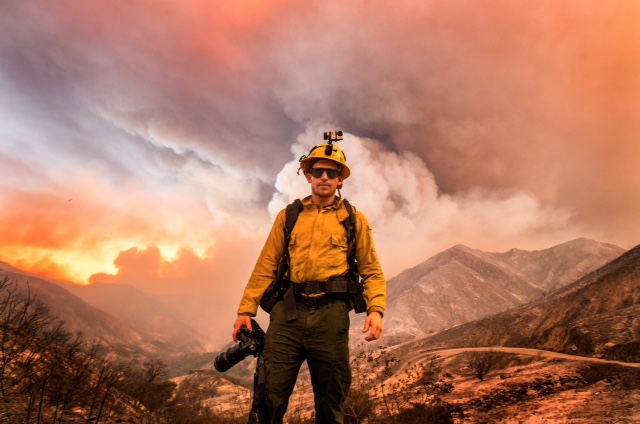
During the film camera days, the most renowned 20th century landscape photographers claimed they could pre-visualize the photographic print even before opening the camera’s shutter. The discipline involved studying the scene, refining the shooting angle and selecting the proper camera settings. Based on the fact that your landscape scenes start out all but obscured by darkness and smoke, how do you decide what view and exposure will yield a good photograph?
There are a couple of factors I take into consideration when assessing the scene to photograph a wildfire at night. First, I want to photograph the fire in the context of the geographic location. Is it in the mountains with large pine trees and steep slopes? Is it burning in a wildland area near homes? Is the fire slowing down at night or burning actively? I like to look for viewpoints or angles that give the viewer this information in an image.
I also like to show the scale of humankind compared to the size of the fires. Individual headlamps on a hillside, the circling of an aircraft overhead and fire engine headlights give a sense of scale. I certainly have a visual concept or idea in my mind that I try and create at each fire. Usually I’ll move from spot to spot at fires, working on the view and angle to get all the elements I’m looking for in the frame.
Scouting out and finding locations in the dark while the fire is burning probably is the most challenging aspect of the project.
Exposure-wise, I usually go for 15 seconds or more to show the movement of the fire and smoke in relation to the topography. Most of the exposures are under 30 seconds, especially when there is the Milky Way or stars to minimize motion blur.
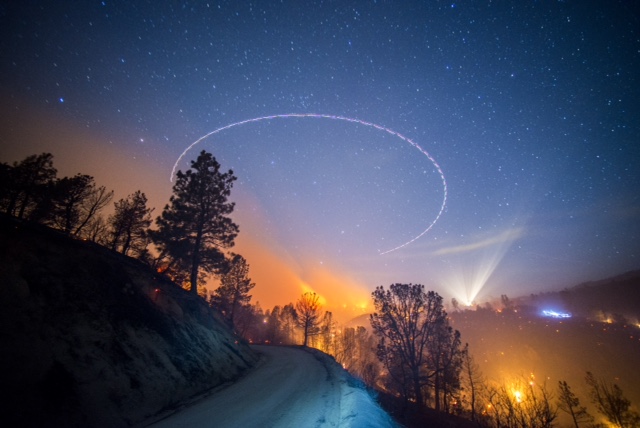
Your image of the Shirley Fire is a dazzling composition of colors, shapes and depth. You’ve got the heavens and hell in one frame. How long did you keep the shutter open to record the trail of the helicopter? Did the aircraft circle around long enough for you to adjust your composition or get a second shot?
The Shirley Fire image was about 30 seconds or one minute. I like that exposure time because it will freeze the stars and Milky Way, but still show flight motion of aircraft and the movement of firefighters on the ground. Yes, I was lucky because the helicopter was doing multiple orbits over the fire in between drops, and I had a few chances to make that frame, but it wasn’t a very long window.
I recall vividly making the picture, because earlier in the day I had tripped on a sprinkler head and gotten what turned out to be a hairline fracture on my little toe, and my foot was throbbing in pain as I hiked around in fire boots making pictures that night. It was only two days later when I got home from the fire that I got X-rayed and found out there was a break.
Your Meadow Fire photograph of the iconic El Capitan Peak in California’s Yosemite National Park is a dystopian depiction of a World Heritage site, yet it’s achingly lovely. When you first viewed the digital image that popped up on your camera’s preview screen, what did you say to yourself? Did you yell into the night? Did your eyes pop out of your head? When I first saw it on my 27” monitor, I said to myself, “Holy shit!”
Going back to the first question, if there was ever an image from the Terra Flamma project that was pre-visualized, it was this one. I always thought that if I could photograph a wildfire amongst a national treasure or feature like the places in Yosemite National Park, it would put front and center wildfires and the related drought and climate issues in a context that people and lovers of the outdoors could relate to.
I actually drove to Yosemite at 5 p.m. that afternoon, getting up to the park at about 11 p.m. I stayed up most of the night, and made the image just as the first bit of light crept over the eastern horizon. I made a dozen frames, and the light changed so the light of the fire wasn’t balanced with the sky anymore. Once I made the picture, however, I knew it would probably be my favorite frame of that fire season, if not the project.
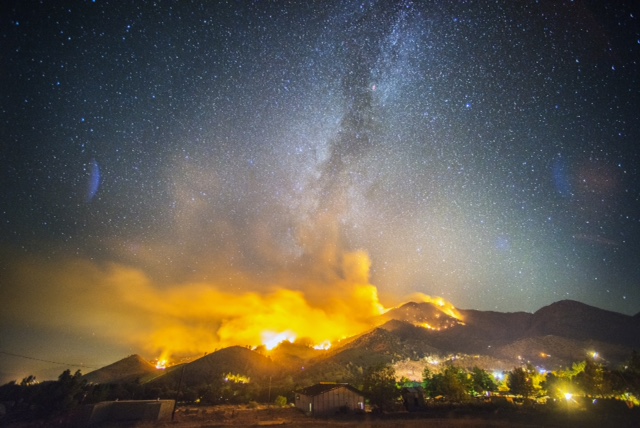
3:51am. 30 seconds with 14mm lens @f.2.8. Stuart Palley
Saffron-tinted smoke from the Way Fire drifts up into a cobalt blue sky and the veil of the Milky Way. The image is insanely beautiful, like Van Gogh’s Starry Night. It’s at once a cosmic dreamscape yet reveals the newsworthy threat to life and property. How do you categorize your work? Is it photojournalism, or art?
Terra Flamma is fundamentally a documentary journalism project photographing wildfires, the most acute effect of drought and related climate issues in California. However, the aim of the project is to try and photograph the fires in a different way, one that would make a viewer examine the image and perhaps pique their interest and educate themselves more on wildfires the forces behind them. In that respect, the project could be labeled art because I am reacting to the typical wildfire photo coverage and attempting to create a body of work.
Perhaps it’s a blend of the two, documentary journalism photographed in a fine-art style. However, all images are of course made under photojournalism industry best practices and are always single exposures with the fact that they are “time exposures” always disclosed.
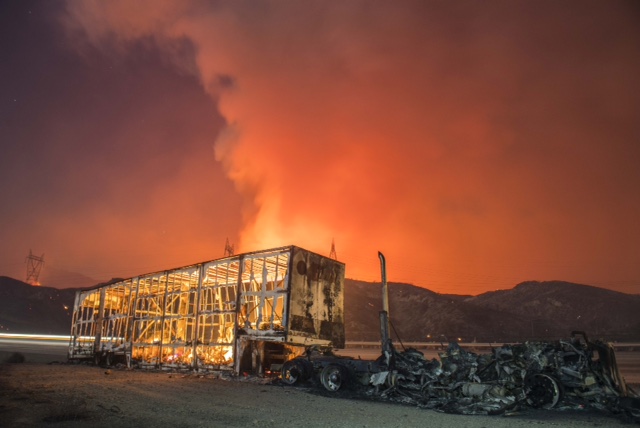
The sleeper cab semi-trailer truck you photographed alongside a freeway during the Blue Cut Fire looks like a toy left too close to the campfire. How could a $200,000 transcontinental highway ark melt like a plastic model?
The Blue Cut Fire’s extreme fire behavior was influenced by high wind speeds, low humidity, and hot temperatures during Red Flag fire conditions. Critically dry fuels also contributed to the fire behavior that caused the fire to burn right over Interstate 15. The fire was so hectic that evening and things were happening so fast, I was moving around making as many images as possible before the end of the night.
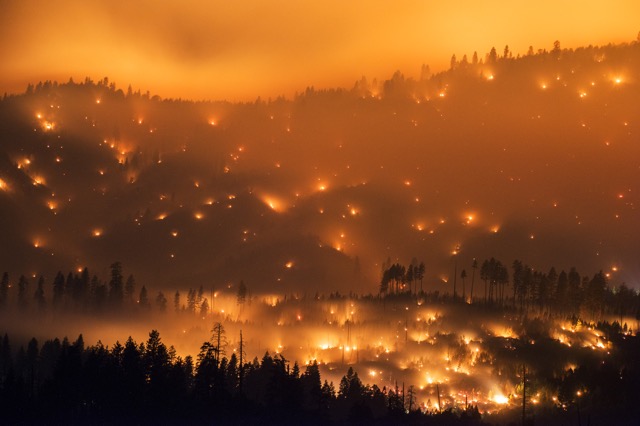
Your 260-second time exposure – nearly 4½ minutes -- of the El Portal Fire is a constellation of “spot fires” amid the remnants of a pine forest. Tell us something about what it looked like out there as you were setting up your camera. Does this image reveal more than is visible to the naked eye?
I photographed the El Portal Fire across the valley from Glacier Point Road, and had a view of the entire burning hill/mountain. The entire hillside was covered in spot fires, so I used a 200-400 lens to compress the view and really focus in on a wall of burning and smoldering trees. I really wanted to bring out the scale of the entire mountainside having been on fire and smoldering, each spot fire a tree or brush no longer.
Yes, the image does reveal more than what is visible to the naked eye. Since it is a long exposure, the camera is recording all of the light over those 4 ½ minutes, whereas our eyes see at roughly 1/30 of a second. So, the camera is capturing much more light than what we see in a given period of time. However, our eyes are amazing at coordinating with our brains for pictures of high dynamic range and color to give the picture we see. The camera generally tries to approximate that same vision that humans have, but is able to record it over longer periods of time.
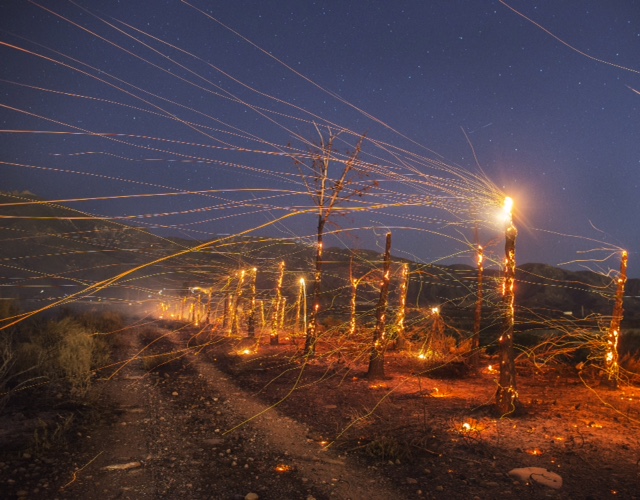
Wind-blown sparks from burned trees at the Etiwanda Fire look like tracer bullets fired from a machine gun. The wind must have been howling. What motivates you to roam around at night with reserves of energy for such creativity?
The motivation to photograph fires overnight comes from needing to be 100% switched on and mentally focused while working. Keeping situational awareness is critical to staying safe at wildfires, so I try and stay focused, and making pictures and working through that creative process energizes me and keeps me to the task on hand. I crash after, though, and usually need a day or two of rest after fires. Pulling all-nighters and all of the smoke inhalation lead to what I call “fire hangovers,” where you wake up feeling like a truck hit you. The combined dehydration, lack of sleep and smoke is physically taxing. I also drink plenty of coffee and stay hydrated with water and Gatorade, and also lots of high-energy snacks like trail mix. However, wildland firefighters spend up to 14 days at a time on the fire line, doing arduous labor, so it pales in comparison to their efforts.
As far as the embers go, during that fire the top wind gust were over 100 mph, and aircraft couldn’t fly. It’s been the only time my Nomex [a trademark brand of fire resistant fabric] has actually caught on fire, when an ember got wedged between my collar and shoulder.



